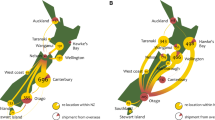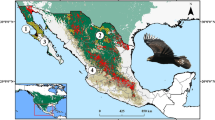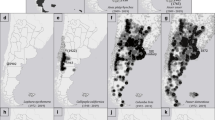Abstract
Understanding the factors influencing the establishment of non-native species is pivotal with regards to the development of effective biosecurity policies. In this paper, we aim to assess the role of climate matching, trade patterns and breeding origin as drivers of establishment success of introduced lovebirds (Agapornis species). A comprehensive database on the worldwide distribution of eight species of non-native lovebirds (including establishment success and population size from 21 countries spanning 27 years) was compiled. We combined climate-based species distribution models with environmental niche analyses to evaluate environmental suitability and potential niche shifts in the introduced range of lovebirds. Then, we tested whether combining habitat suitability with information on trade, introduction effort and breeding origin (captive-bred or wild-caught) of imported birds can improve model predictions at the country level. Although climate-based models fit well with the current distribution of non-native lovebirds at 5-arcminute resolution and significant niche similarity was found for 3 species, we also observed successful establishments in areas climatically distinct from those occupied in native ranges. At the country level, only a significant relationship between the number of established populations and both the number of introduction sites and the year of first importation was observed. A significant effect of breeding origin was not found, but most traded birds had a captive-bred origin. Our work contributes to the growing evidence of the complexity of the invasion process and the difficulty of pre-introduction invasion assessments based solely on the characteristics of the recipient environments for the Agapornis species. Surveillance protocols should be applied to both wild-caught and captive-bred lovebirds, as additional data becomes available to better tease apart the role of origin in those species.



Similar content being viewed by others
References
Aagaard K, Lockwood J (2014) Exotic birds show lags in population growth. Divers Distrib 20:547–554
Abellán P, Tella JL, Carrete M, Cardador L, Anadón JD (2017) Climate matching drives spread rate but not establishment success in recent unintentional bird introductions. Proc Natl Acad Sci USA 114:9385–9390
Allendorf FW, Luikart G (2009) Conservation and the genetics of populations. Wiley, New York
Allouche O, Tsoar A, Kadmon R (2006) Assessing the accuracy of species distribution models: prevalence, kappa and the true skill statistic (TSS). J Appl Ecol 43:1223–1232
Ammon U (2001) The dominance of English as a language of science: effects on other languages and language communities. Walter de Gruyter Editions, Berlin
Ancillotto L, Strubbe D, Menchetti M, Mori E (2015) An overlooked invader? Ecological niche, invasion success and range dynamics of the Alexandrine parakeet in the invaded range. Biol Invasions 18:583–595
Andreotti A, Baccetti N, Perfetti A, Besa M, Genovesi P, Guberti V (2001) Mammiferi ed Uccelli esotici in Italia: analisi del fenomeno, impatto sulla biodiversità e linee guida gestionali. MATTM e Ist.Naz. Fauna Selvatica, Roma, Italy
Basso R, Vannuccini ML, Nerva L, Mazza G, Seno M, Mori E (2019) Multiple origins of the common chameleon in southern Italy. Herpetozoa 32:11
Bertolino S, Genovesi P (2003) Spread and attempted eradication of the grey squirrel (Sciurus carolinensis) in Italy, and consequences for the red squirrel (Sciurus vulgaris) in Eurasia. Biol Conserv 109:351–358
Blackburn TM, Lockwood JL, Cassey P (2009) Avian invasions. The ecology and evolution of exotic birds. Oxford University Press, Oxford
Blackburn TM, Lockwood JL, Cassey P (2015) The influence of numbers on invasion success. Mol Ecol 24:1942–1953
Breiman L (2001) Random forests. Mach Learn 45:5–32
Broennimann O, Fitzpatrick MC, Pearman PB, Petitpierre B, Pellissier L, Yoccoz NG, Thuiller W, Fortin MJ, Randin C, Zimmerman NE, Graham CH, Guisan A (2012) Measuring ecological niche overlap from occurrence and spatial environmental data. Glob Ecol Biogeogr 21:481–497
Cabezas S, Carrete M, Tella JL, Marchant TA, Bortolotti GR (2013) Differences in acute stress responses between wild-caught and captive-bred birds: a physiological mechanism contributing to current avian invasions? Biol Invasions 15:521–527
Cardador L, Carrete M, Gallardo B, Tella JL (2016) Combining trade data and niche modelling improves predictions of the origin and distribution of non-native European populations of a globally invasive species. J Biogeogr 43:967–978
Cardador L, Lattuada M, Strubbe D, Tella JL, Reino L, Figueira R, Carrete M (2017) Regional bans on wild-bird trade modify invasion risks at a global scale. Conserv Lett 10:717–725
Cardador L, Tella JL, Anadón JD, Abellán P, Carrete M (2019) The European trade ban on wild birds reduced invasion risks. Conserv Lett 12(3):e12631
Carrete M, Tella JL (2008) Wild-bird trade and exotic invasions: a new link of conservation concern? Front Ecol Environ 6:207–211
Carrete M, Tella JL (2015) Rapid loss of antipredatory behaviour in captive-bred birds is linked to current avian invasions. Sci Rep 5:18274
Cassey P, Blackburn TM, Russel GJ, Jones KE, Lockwood JL (2004) Influences on the transport and establishment of exotic bird species: an analysis of the parrots (Psittaciformes) of the world. Glob Change Biol 10:417–426
Cassey P, Vall-Llosera M, Dyer E, Blackburn TM (2015) The biogeography of avian invasions: history, accident and market trade. In: Canning-Clode J (ed) Biological Invasions in changing ecosystems: vectors, ecological impacts, management and predictions. De Gruyter Open Editions, Warsaw, pp 37–54
Clergeau P, Vergnes A (2011) Bird feeders may sustain feral Rose-ringed parakeets Psittacula krameri in temperate Europe. Wildlife Biol 17:248–252
Colautti RI, Grigorovich IA, MacIsaac HJ (2006) Propagule pressure: a null model for biological invasions. Biol Invasions 8:1023–1037
Crowley SL, Hinchliffe S, McDonald RA (2019) The parakeet protectors: understanding opposition to introduced species management. J Environ Manage 229:120–132
Darling JA, Bagley MJ, Roman JOE, Tepolt CK, Geller JB (2008) Genetic patterns across multiple introductions of the globally invasive crab genus Carcinus. Mol Ecol 17:4992–5007
Di Cola V, Broennimann O, Petitpierre B et al (2017) Ecospat: an R package to support spatial analyses and modeling of species niches and distributions. Ecography 40:774–787
Di Febbraro M, Menchetti M, Russo D, Ancillotto L, Aloise G, Roscioni F, Preatoni DG, Loy A, Martinoli A, Bertolino S, Mori E (2019) Integrating climate and land-use change scenarios in modelling the future spread of invasive squirrels in Italy. Divers Distrib 25:644–659
Duncan RP, Blackburn TM, Sol D (2003) The ecology of bird introductions. Annu Rev Ecol Evol Syst 34:71–98
Durka W, Bossdorf O, Prati D, Auge H (2005) Molecular evidence for multiple introductions of garlic mustard (Alliaria petiolata, Brassicaceae) to North America. Mol Ecol 14:1697–1706
Early R, Sax DF (2014) Climatic niche shifts between species’ native and naturalized ranges raise concern for ecological forecasts during invasions and climate change. Glob Ecol Biogeogr 23:1356–1365
Edelaar P, Roques S, Hobson EA, Gonçalves da Silva A, Avery ML, Russello MA, Senar JC, Wright TF, Carrete M, Tella JL (2015) Shared genetic diversity across the global invasive range of the monk parakeet suggests a common restricted geographic origin and the possibility of convergent selection. Mol Ecol 24:2164–2176
Elith J, Kearney M, Phillips S (2010) The art of modelling range-shifting species. Methods Ecol Evol 1:330–342
Estévez RA, Anderson CB, Pizarro JC, Burgman MA (2015) Clarifying values, risk perceptions, and attitudes to resolve or avoid social conflicts in invasive species management. Conserv Biol 29:19–30
Forshaw JM (2010) Parrots of the world: a field guide (Helm Field Guides). Cristopher Helm, London
Friedman JH (2001) Greedy function approximation: a gradient boosting machine. Ann Stat 29:1189–1232
Genovesi P, Shine C (2004) European strategy on invasive alien species: convention on the conservation of European wildlife and habitats (bern convention) (no. 18-137). Council of Europe, Strasbourg
Gering JC, Blair RB (1999) Predation on artificial bird nests along an urban gradient: predatory risk or relaxation in urban environments? Ecography 22:532–541
Gismondi E (1991) Il grande libro degli Uccelli da gabbia e da voliera. Milano, Italy: De Vecchi Editors, Milano, Italy
Guisan A, Petitpierre B, Broennimann O, Daehler C, Kueffer C (2014) Unifying niche shift studies: insights from biological invasions. Trends Ecol Evol 29:260–269
Hijmans RJ, Cameron SE, Parra JL, Jones PG, Jarvis A (2005) Very high resolution interpolated climate surfaces for global land areas. Int J Climatol 25:1965–1978
Hirzel AH, Le Lay G, Helfer V, Randin C, Guisan A (2006) Evaluating the ability of habitat suitability models to predict species presences. Ecol Model 1999:142–152
Holt RD, Barfield M, Gomulkiewicz R (2005) Theories of niche conservatism and evolution: could exotic species be potential tests? In: Sax DF, Stachowicz JJ, Gaines SD (eds) Species invasions: insights into ecology, evolution and biogeography. Sinauer Associates, Sunderland, pp 259–290
Hulme PE (2015) Invasion pathways at a crossroad: policy and research challenges for managing alien species introductions. J Appl Ecol 52:1418–1424
Laurenti S, Paci AM (2015) Check-list degli Uccelli dell’Umbria aggiornata al luglio 2015. Uccelli d’Italia 40:109–116
Le Louarn M, Clergeau P, Strubbe D, Deschamps-Cottin M (2018) Dynamic species distribution models reveal spatiotemporal habitat shifts in native range-expanding versus non-native invasive birds in an urban area. J Avian Biol 49:4
Leung B, Lodge DM, Finnoff D, Shogren JF, Lewis MA, Lamberti G (2002) An ounce of prevention or a pound of cure: bioeconomic risk analysis of invasive species. Proc R Soc Lond Ser B-Biol Sci 269:2407–2413
Lever C (1987) Naturalized birds of the world. Longman scientific and techinical editors. Harlow, Essex, UK
Lever C (2005) Naturalized birds of the world. T and A D Poyser Editions, London
Lockwood JL, Cassey P, Blackburn T (2005) The role of propagule pressure in explaining species invasions. Trends Ecol Evol 20:223–228
Luna A, Edelaar P, Shwartz A (2019) Assessment of social perception of an invasive parakeet using a novel visual survey method. Neobiota 46:71–89
Mateo RG, Broennimann O, Petitpierre B, Muñoz J, van Rooy J, Laenen B, Guisan A, Vanderpoorten A (2014) What is the potential of spread in invasive bryophytes? Ecography 38:480–487
McCullaghm P, Nelder J (1989) Generalized linear models, Standard book on generalized linear models, 2nd edn. Chapman-Hall, London
Menchetti M, Mori E (2014) Worldwide impact of alien parrots (Aves Psittaciformes) on native biodiversity and environment: a review. Ethol Ecol Evol 26:172–194
Mori E, Monaco A, Sposimo P, Genovesi P (2014) Low establishment success of alien non-passerine birds in a Central Italy wetland. Ital J Zool 81:593–598
Mori E, Grandi G, Menchetti M, Tella JT, Jackson HA, Reino L, van Kleunen A, Figueira R, Ancillotto L (2017) Worldwide distribution of non-native Amazon parrots and temporal trends of their global trade. Anim Biodivers Conserv 40:49–62
Mori E, Zozzoli R, Menchetti M (2018a) Global distribution and status of introduced Siberian chipmunks Eutamias sibiricus. Mammal Rev 48:139–152
Mori E, Milanesi P, Menchetti M, Zozzoli R, Monaco A, Capizzi D, Nerva L (2018b) Genetics reveals that free-ranging chipmunks introduced to Italy have multiple origins. Hystrix 29:239–242
Mori E, Menchetti M, Zozzoli R, Milanesi P (2019) The importance of taxonomy in species distribution models at a global scale: the case of an overlooked alien squirrel facing taxonomic revision. J Zool 307:43–52
Niemelä J, Breuste JH, Elmqvist T, Guntenspergen G, James P, Mcintyre NE (2011) Urban ecology: patterns, processes, and applications. Oxford University Press, Oxford
Nijman V, Shepherd CR, Sanders KL (2012) Over-exploitation and illegal trade of reptiles in Indonesia. Herpetol J 22:83–89
Olson DM, Dinerstein E, Wikramanayake ED, Burgess ND, Powell GV, Underwood EC, D’Amico JA, Itoua I, Strand HE, Loucks JCMCJ, Allnutt TF, Ricketts TH, Kura Y, Lamoreux JF, Wettengel WW, Hedao P, Kassem RK, Kassem KR (2001) Terrestrial ecoregions of the world: a new map of life on Earth. BioScience 51:933–938
Pârâu LG, Strubbe D, Mori E, Menchetti M, Ancillotto L, van Kleunen A, White RL, Luna A, Hernandez-Brito D, Le Louarn M, Clergeau P, Albayrak T, Franz D, Braun MP, Schroeder J, Wink M (2016) Rose-ringed parakeet Psittacula krameri populations and numbers in Europe: a complete overview. Open Ornithol J 9:1–13
Petitpierre B, Kueffer C, Broennimann O, Randin C, Daehler C, Guisan A (2012) Climatic niche shifts are rare among terrestrial plant invaders. Science 335:1344–1348
Phillips SJ, Anderson RP, Schapire RE (2006) Maximum entropy modeling of species geographic distributions. Ecol Model 190:231–259. https://doi.org/10.1016/j.ecolmodel.2005.03.026
Pigot AL, Cassey P, Blackburn TM (2018) How to incorporate information on propagule pressure in the analysis of alien establishment success. Methods Ecol Evol 9:1097–1108
Postigo J-L, Strubbe D, Mori E, Ancillotto L, Carneiro I, Latsoudis P, Menchetti M, Pârâu LG, Parrott D, Reino L, Weiserbs A, Senar JC (2019) Mediterranean versus Atlantic monk parakeets Myiopsitta monachus: towards differentiated management at the European scale. Adv Sci 75:915–922
R Core Team (2017) R: A language and environment for statistical computing. R Foundation for Statistical Computing, Vienna, Austria. ISBN 3-900051-07-0, URL http://www.R-project.org/
Reino L, Figueira R, Beja P, Araújo MB, Capinha C, Strubbe D (2017) Networks of global bird invasion altered by regional trade ban. Sci Adv 3:e1700783
Sales LP, Ribeiro BR, Hayward MW, Paglia A, Passamani M, Loyola R (2017) Niche conservatism and the invasive potential of the wild boar. J Anim Ecol 86:1214–1223
Schoener TW (1970) Nonsynchronous spatial overlap of lizards in patchy habitats. Ecology 51:408–418
Simberloff D (2009) The role of propagule pressure in biological invasions. Annu Rev Ecol Evol Syst 40:81–102
Sorace A (2002) High density of bird and pest species in urban habitats and the role of predator abundance. Ornis Fennica 79:60–71
Stockwell DR, Peterson AT (2002) Effects of sample size on accuracy of species distribution models. Ecol Model 148:1–13
Strubbe D, Matthysen E (2009) Establishment success of invasive ring-necked and monk parakeets in Europe. J Biogeogr 36:2264–2278
Strubbe D, Broennimann O, Chiron F, Matthysen E (2013) Niche conservatism in non-native birds in Europe: niche unfilling rather than niche expansion. Glob Ecol Biogeogr 22:962–970
Strubbe D, Jackson H, Groombridge J, Matthysen E (2015) Invasion success of a global avian invader is explained by within-taxon niche structure and association with humans in the native range. Divers Distrib 21:675–685
Taha H (1997) Urban climates and heat islands: albedo, evapotranspiration, and anthropogenic heat. Energy Build 25:99–103
Tella JL, Hiraldo F (2014) Illegal and legal parrot trade shows a long-term, cross-cultural preference for the most attractive species increasing their risk of extinction. PLoS ONE 9:e107546
Thuiller W, Richardson D, Pysek P, Midgley G, Hughes GO, Rouget M (2005) Niche-based modelling as a tool for predicting the risk of alien plant invasions at aglobal scale. Glob Change Biol 11:2234–2250
Thuiller W, Lafourcade B, Engler R, Araújo MB (2009) BIOMOD: a platform for ensemble forecasting of species distributions. Ecography 32:369–373
Uehling JJ, Tallant J, Pruett-Jones S (2019) Status of naturalized parrots in the United States. J Ornithol 160:907
Warren DL, Glor RE, Turelli M (2008) Environmental niche equivalency versus conservatism: quantitative approaches to niche evolution. Evolution 62:2868–2883
Westphal MI, Browne M, MacKinnon K, Noble I (2008) The link between international trade and the global distribution of invasive alien species. Biol Invasions 10:391–398
White RL, Strubbe D, Dallimer M, Davies ZG, Davis AJ, Edelaar P, Groombridge JJ, Jackson H, Menchetti M, Mori E, Nikolov BP, Pârâu LG, Pečnikar ŽF, Pett TJ, Reino L, Tollington S, Turbé A, Shwartz A (2019) Assessing the ecological and societal impacts of alien parrots in Europe using a transparent and inclusive evidence-mapping scheme. NeoBiota 48:45–69
Acknowledgements
We thank Leonardo Ancillotto for useful recommendations and help in data collection. We are also grateful to Miguel Porto for helping us with the trade graphics. The realisation of this manuscript was supported by the European Cooperation in Science and Technology COST Action ES1304 (ParrotNet). The contents of this paper are the authors’ responsibility and neither COST nor any person acting on its behalf is responsible for the use that might be made of the information contained in it. Luís Reino was funded by FEDER Funds through the Operational Competitiveness Factors Program “COMPETE”, and by National Funds through the Foundation for Science and Technology (FCT) within the framework of the Project “PTDC/AAG-GLO/0463/2014-POCI-01-0145-FEDER-016583” and FCT Post-doc Grant SFRH/BPD/93079/2013. LC was funded by the H2020-MSCA-IF-2016 fellowship No. 752149. EM, MM and LC conceived the idea and led the writing of the manuscript; LC conducted most of the analyses. LM organized the first dataset on data collected by DHB, RLW, LR, PE, BN, LGP and MLL, LR analysed and wrote the part focusing on trade. All authors participated in writing the final manuscript. Two anonymous reviewers and the Editor-in-Chief, Prof. Daniel Simberloff, kindly provided us with constructive comments on our first draft.
Author information
Authors and Affiliations
Corresponding author
Additional information
Publisher's Note
Springer Nature remains neutral with regard to jurisdictional claims in published maps and institutional affiliations.
Electronic supplementary material
Below is the link to the electronic supplementary material.
Rights and permissions
About this article
Cite this article
Mori, E., Cardador, L., Reino, L. et al. Lovebirds in the air: trade patterns, establishment success and niche shifts of Agapornis parrots within their non-native range. Biol Invasions 22, 421–435 (2020). https://doi.org/10.1007/s10530-019-02100-y
Received:
Accepted:
Published:
Issue Date:
DOI: https://doi.org/10.1007/s10530-019-02100-y




